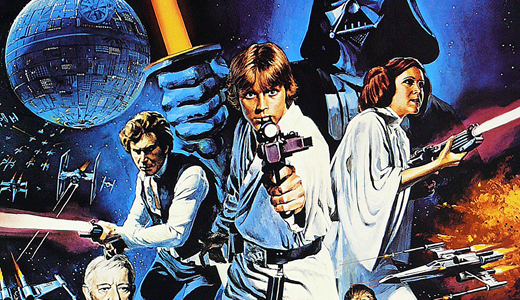When I was just a wee lad wearing bell-bottoms back in 1977, I bounded into a tiny movie theater in New Mexico to watch a little film called Star Wars.
And my 8-year-old mind was blown.
I didn’t see it on opening day—May 25, 1977, exactly 40 years ago today. The film (now known to some whippersnappers as Star Wars Episode IV: A New Hope) debuted in just 32 theaters, and the one in Taos didn’t make the cut. But that didn’t stop me from seeing the thing four times during the week it played there. For me, it wasn’t just a movie: It was a life-changing experience. I’m pretty sure I wouldn’t be doing what I do had it not been for Star Wars.
But it didn’t just change my life: It’s changed yours, too—even if you don’t know the difference between Mace Windu and a Wampa.
Not much was expected of George Lucas’s passion project. Science fiction was the province of cheap B-movies back then, and several studios declined to fund the film, with Universal Pictures calling it “a little strange.” 20th Century Fox eventually picked the project up, but still didn’t think much of it. The Other Side of Midnight was supposed to be the studio’s big hit. In fact, the studio essentially bribed theaters to show Star Wars by telling them that if they did, they’d have the rights to screen The Other Side of Midnight as well. (The relationship between studios and theaters was a bit different then.)
We all know what happened. Star Wars became the biggest box-office smash in nearly 40 years. If you adjust for inflation, Star Wars earned the equivalent of $1.6 billion in North America, making it the second-highest-grossing movie of all time (behind Gone With the Wind’s $1.8 billion). (Take that, Avatar!) And its success completely transformed the movie industry.
Consider the typical hit film before Star Wars. Movies such as Rocky (1976’s biggest hit) and The Exorcist (1973) and Love Story (1970) were primarily for adults. Sure, parents might take their kids to see Rocky, but the idea of a “four-quadrant” film—something that would appeal to every conceivable demographic—hadn’t really been defined. None of those films were released during the summer: Studio execs assumed that most people would rather be outside in the summer than in a dark theater. They were original stories, too. Sequels were a rarity back then, sequestered to successful-but-lightweight franchises like The Pink Panther. The Godfather Part II, released in 1974, was an anomaly.
And merchandise? Yeah, the local Kmart wasn’t bedecked in Exorcist action figures or Rocky Balboa toothbrushes. You didn’t see Love Story television spinoffs or Godfather games.
Star Wars changed all that. It made science fiction cool and turned the four-quadrant action-adventure yarn into Hollywood’s undisputed cash cow. It, along with 1975’s Jaws, defined the modern blockbuster and proved that summertime was prime movie-seeing time. When the Star Wars sequel The Empire Strikes Back was released, it further defined the concept of an “event” movie and proved the financial viability of the sequel—at least for a high-level property. The success of George Lucas’s films helped spawn a sprawling extended universe: New Star Wars stories were told in books, television shows, comic books and video games even before the prequels and sequels were unveiled.
And then consider the toys.
More than 300 million action figures and sets were sold by Kenner by 1985 alone, according to statisticbrain.com, and more than 12 billion toys and collectibles have been moved overall. 138 Star Wars-related video games have generated another $3.4 billion in sales, while 358 books (by 76 different authors) account for another $1.8 billion. Last year, Variety reported that global movie-related merchandise generated a staggering $251.7 billion—a market that largely didn’t exist before 1977.
Go to the local multiplex today, and what dominates? Science fiction. Special effects. Sequels. Powerhouse franchises with robust fictional worlds.
Take Guardians of the Galaxy Vol. 2: This franchise-within-a-franchise overflows with special effects and oodles of merchandising. Oh, and it also features a ragtag group of do-gooders trying to save the galaxy. Yep, Guardians bears a striking, almost eerie family resemblance to its cinematic ancestor.
Without Star Wars, there’d be no Guardians. Moreover, there’d be no Fate of the Furious. No Wonder Woman or Kong: Skull Island or Pirates of the Caribbean: Dead Men Tell No Tales. If you ever complain that Hollywood has become too derivative and seems to have forsaken original stories, well, you have Star Wars to blame.
But it also proves the power of a good story told well, too. And Star Wars, for all its flaws, is that. I wasn’t charmed by the movie’s money or merchandise, but by its story—a story of good and evil, of laser blasters and lightsabers that transported me to a place long, long ago, in a galaxy far, far away.
Stories can indeed change the world. And Star Wars, in its own strange way, proves it.






Recent Comments